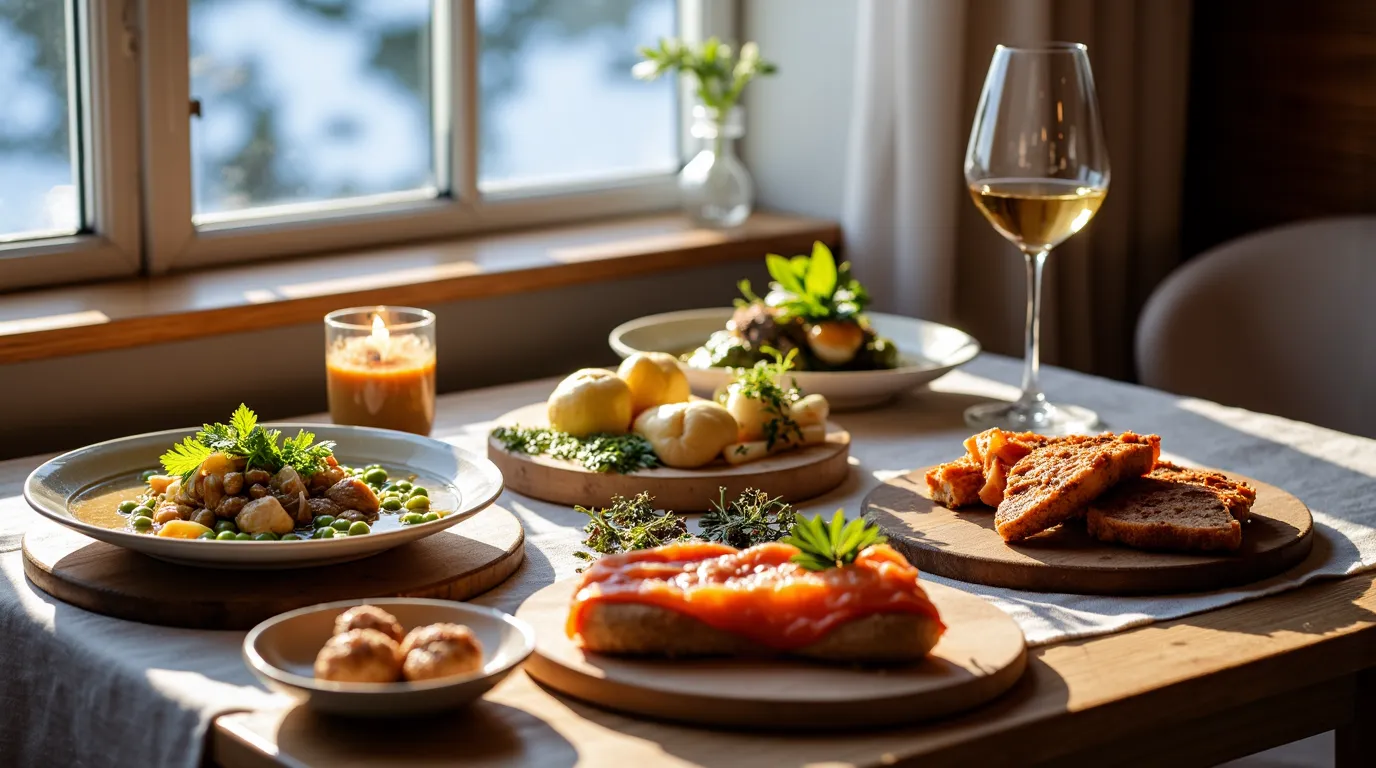Table of Contents
Table of Contents
Introduction
Norway is a country of astonishing natural beauty, with majestic fjords, rugged mountains, and pristine coastlines that have shaped its people, traditions, and gastronomic practices for centuries. Within this breathtaking landscape, Norwegian cuisine has emerged as a remarkable culinary tapestry woven from the threads of the country’s history, climate, and cultural identity. From the salty tang of dried fish that once fueled Viking expeditions to the modern reimagining of traditional recipes by innovative chefs, Norwegian cuisine serves as a fascinating window into the heart and soul of the Norwegian people.
One of the most striking aspects of Norwegian cuisine is how closely it is tied to its geography and climate. The long, harsh winters and relatively short growing seasons have historically demanded creative resourcefulness in food preparation and preservation methods. Moreover, the proximity of Norway’s extensive coastline to the bountiful North Atlantic has instilled in its cuisine a deep reverence for seafood, with various fish species — from cod to salmon — taking center stage in numerous dishes.
In recent decades, Norway has experienced a gastronomic renaissance. Although the core of Norwegian cuisine remains deeply rooted in tradition, there has been an upsurge in internationally trained chefs and an openness to external influences that have gradually reshaped culinary conventions. Today, adventurous palates can explore both the comforting flavors of time-honored classics and the modern fusion twists that effortlessly blend global culinary techniques with Norwegian staples.
This article will take you on a comprehensive journey through Norwegian cuisine. We will delve into the historical and cultural context that shaped its evolution, examine the key ingredients and local products that define it, and spotlight some must-try traditional dishes. We will also discuss its defining characteristics, share tips and highlights to entice first-timers, and elaborate on table rituals and customs that make dining in Norway such an immersive cultural experience. Finally, we will explore the country’s current culinary trends, from cutting-edge fusion restaurants to the growing organic and farm-to-table movement. By the end of this reading, you should be well-equipped to appreciate and perhaps even recreate the delicious traditions that make Norwegian cuisine truly unique.
Culinary Context and History
Historical Roots and Early Influences
Norway’s earliest inhabitants relied heavily on what the land and sea could offer. Archaeological evidence suggests that fishing, hunting, and foraging were at the core of sustenance. Over time, the introduction of basic agriculture shifted dietary habits somewhat, but fishing remained integral. This foundational reliance on available local resources informs the essence of Norwegian cuisine: practicality, seasonality, and ingenuity in preservation.
During the Viking Age (roughly from the late eighth century to the mid-11th century), Norwegian seafarers ventured far beyond their homeland, trading and raiding across vast territories. This period was crucial in spreading certain food products and influencing local gastronomy. For example, dried fish (stockfish) played a significant role in Viking expeditions, as it was lightweight, nutrient-dense, and had a long shelf life. The salted or dried fish eventually found its way to trading hubs, disseminating Norwegian fish products across Europe.
Medieval Period and Foreign Influences
The consolidation of Norway under various monarchs and the introduction of Christianity brought new customs and some external culinary inspirations. Religious practices during the medieval period imposed dietary restrictions during Lent, which increased the demand for preserved fish and other ingredients suitable for fasting. At the same time, trade connections, particularly through the Hanseatic League, introduced influences from Germany and beyond. This contributed to the rise of more diverse ingredients like rye, barley, and certain spices that were previously uncommon.
Union Eras and Regional Divergences
Following the medieval era, Norway entered a series of political unions — first with Denmark (from 1536 to 1814), then with Sweden (from 1814 to 1905). Danish influence persisted in the upper echelons of society, but for the majority of rural communities, especially those living in remote regions, food culture remained relatively self-contained and shaped by local conditions. Bread and porridge varieties, largely made from barley or oats, were ubiquitous, while salted, smoked, or dried fish and meats formed the cornerstone of diets throughout the colder months. Potatoes, which arrived in the 18th century, quickly became a staple, profoundly impacting Norwegian cuisine by complementing fish and meat dishes.
By the 19th century, dietary practices began to differ more starkly between regions. In coastal areas, the abundance of fish, shellfish, and seaweed shaped daily meals, while inland regions leaned more on dairy, root vegetables, and game meats like reindeer and elk. Norwegian agriculture often revolved around hardy crops that could endure challenging climatic conditions, reinforcing local distinctions based on what could be successfully grown or foraged. This laid the groundwork for a rich culinary variety from north to south and east to west.
Geographical and Cultural Influences
Stretching from the temperate southern coast near Oslo to the Arctic Circle, Norway’s elongated geography has produced vast cultural, linguistic, and culinary variations. The north is home to the Sami people, who have their own distinct food traditions built around reindeer herding and preserving wild resources. In the west, the dramatic fjords offer plentiful fish and seafood, accompanied by small-scale farms where goats produce rich cheeses. Eastern regions around Oslo historically experienced greater connectivity with the rest of Europe, hence showing slightly stronger foreign influences. The south, known for its milder climate and fertile land, supports diverse produce and has a growing orchard tradition.
Major Events Shaping Norwegian Cuisine
- Viking Age (8th-11th century): Expansion, trade, and the spread of preserved fish.
- Introduction of Christianity (11th century onward): Influence on fasting customs, increased demand for certain preserved foods.
- Hanseatic League trade (13th-17th century): Introduction of new grains, spices, and cooking techniques.
- Political Unions (16th-19th century): Danish and Swedish influences, but rural areas remained relatively isolated, preserving local traditions.
- 19th Century National Romanticism: Resurgence of interest in Norwegian cultural identity, which included the celebration of local food traditions.
- 20th Century Modernization: Technological advancements in fishing, farming, refrigeration, and later an openness to global cuisines that spurred new trends.
Throughout these waves of influences, Norwegian cuisine has always maintained a strong link to its environment and climate, ensuring that much of its traditional fare remains uniquely tied to Norway’s cold waters, fertile valleys, and rugged mountain terrains.
Key Ingredients and Local Products
Seafood:
Arguably the cornerstone of Norwegian cuisine, seafood such as salmon, cod (including the famed skrei during the winter season), haddock, halibut, and herring are crucial components of many daily and celebratory meals. The country’s extensive coastline provides fresh fish year-round. Additionally, preserved forms like dried stockfish, salted cod (klippfisk), and pickled herring embody centuries-old preservation methods.
Meats and Game:
Norway’s landscapes are home to an array of wildlife, including reindeer, moose, and grouse. These wild meats are particularly revered in northern and inland regions. Lamb is another favorite, with the iconic fenalår (salted, dried leg of lamb) representing a rustic Norwegian delicacy. Pork and beef appear in various dishes, though often overshadowed by fish in traditional culinary narratives.
Dairy and Cheeses:
Dairy products are highly prized in Norwegian cuisine. From the soft, tangy rømme (sour cream) to a wide variety of artisanal cheeses, dairy plays a vital role. A particularly iconic example is brunost (brown cheese), a caramelized whey cheese with a sweet, fudge-like flavor. Goat cheese varieties are also popular, often featuring distinctly robust tastes.
Fruits and Vegetables:
Due to Norway’s short growing season, root vegetables like potatoes, carrots, turnips, and celeriac remain staples. Potatoes, introduced relatively late in Norwegian history, quickly became integral to daily meals. In regions with milder climates, apples, berries (such as lingonberries, blueberries, and cloudberries), and cherries flourish during the summer and early autumn, influencing the sweet aspect of Norwegian cuisine.
Herbs and Spices:
Traditional Norwegian cooking relies primarily on mild seasonings, allowing the fresh quality of fish, meat, and produce to shine. Dill, parsley, and chives are among the most common herbs, especially when accompanying fish dishes. Certain dishes might incorporate juniper berries (particularly with game meat) or an occasional hint of caraway, though pungent spices are relatively rare.
Seasonality and its Impact
Seasons in Norway are stark and influential in determining what ends up on the plate. Winter necessitates reliance on preserved or dried ingredients, such as salted fish, cured meats, and pickled vegetables. Summer and early autumn are times of bounty, when locals can enjoy fresh produce, berries, and newly caught fish. Seasonal events like the arrival of skrei (Norwegian Arctic cod) in winter or the salmon runs of summer can become culinary celebrations in their own right.
Where to Find Ingredients
For those eager to recreate Norwegian cuisine at home, specialty stores and well-stocked international grocery markets often carry staples like pickled herring, salted cod, and brunost. Many Scandinavian shops outside Norway also offer a broad selection of Norwegian food items, from crispbread (knekkebrød) to cured meats. Local farmers’ markets, if available, might stock root vegetables and fresh herbs reminiscent of Norwegian produce. If certain items, such as reindeer meat, are difficult to source, home chefs can experiment with similar game meats like venison. Ultimately, the essence of Norwegian cooking lies in fresh, high-quality ingredients, so seeking out the best produce and fish is the first step toward authentic results.
Must-Try Traditional Dishes
Norway boasts an array of dishes reflecting centuries of adaptation to its climate and the natural riches of its seas and lands. Below are some of the nation’s most emblematic culinary highlights, as well as simplified tips on how to make or enjoy them.
Fårikål (Lamb and Cabbage Stew)
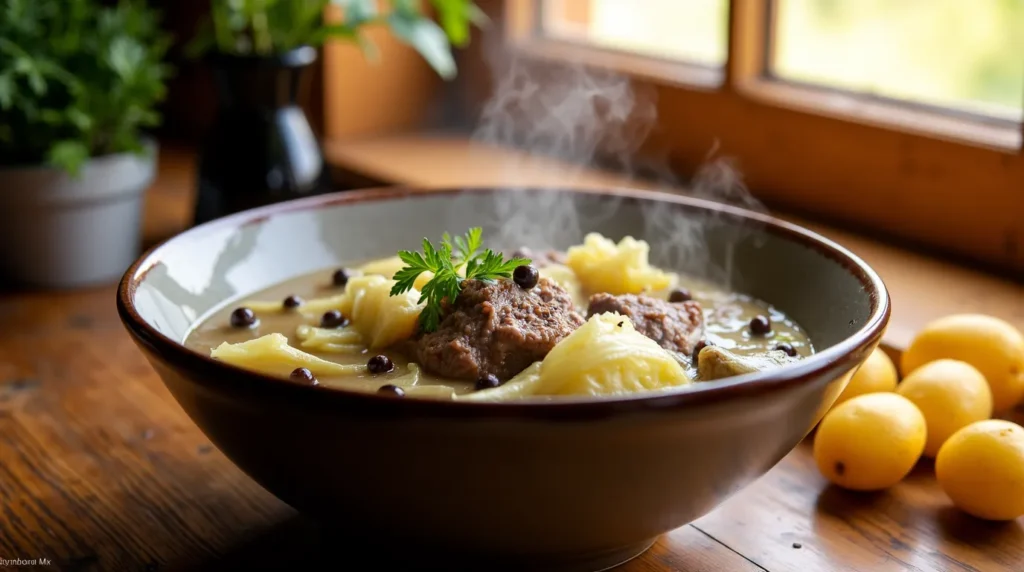
- History and Characteristics: Fårikål is often hailed as Norway’s national dish. It consists of pieces of lamb or mutton simmered with cabbage and whole black peppercorns, producing a hearty, comforting stew. This dish dates back several centuries and showcases the Norwegian preference for simple flavor combinations that let key ingredients shine.
- Ingredients: Lamb (or mutton), cabbage, black peppercorns, salt, and water.
- Regional Variations: In some regions, the stew may be thickened slightly with flour, while others keep it broth-like.
- Simplified Recipe:
- Layer lamb pieces and sliced cabbage in a large pot, seasoning each layer with salt and peppercorns.
- Add enough water to barely cover.
- Bring to a simmer, cover, and cook gently for a few hours until the meat is tender.
- Serve with boiled potatoes and a generous ladle of the savory broth.
Lutefisk
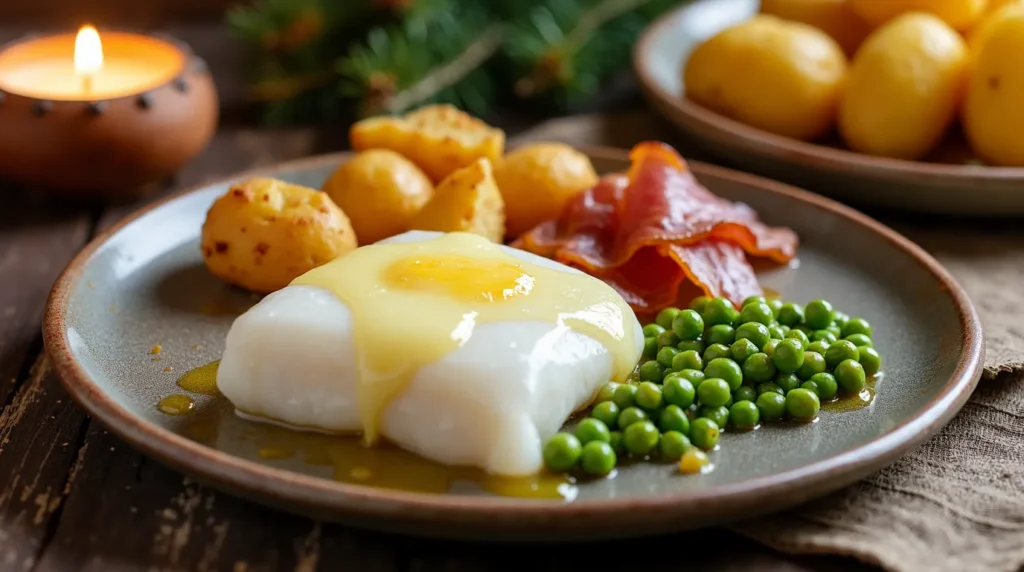
- History and Characteristics: Lutefisk is dried fish (often cod) that has been rehydrated in an alkaline solution of water and lye. The result is a gelatinous texture that surprises many first-time tasters. It has a long tradition in Norwegian Christmas cuisine, particularly in the southern regions.
- Ingredients: Dried cod, lye, water, and typically served with bacon, pea stew, and boiled potatoes.
- Tips for Preparation: Preparing lutefisk from scratch is a process that can take days of soaking. Many Norwegian-Americans and Norwegians alike rely on pre-packaged versions already processed with lye, which only requires final cooking. For novices, it’s recommended to follow an established recipe closely and make sure to ventilate the kitchen, as the odor can be pungent.
Rakfisk
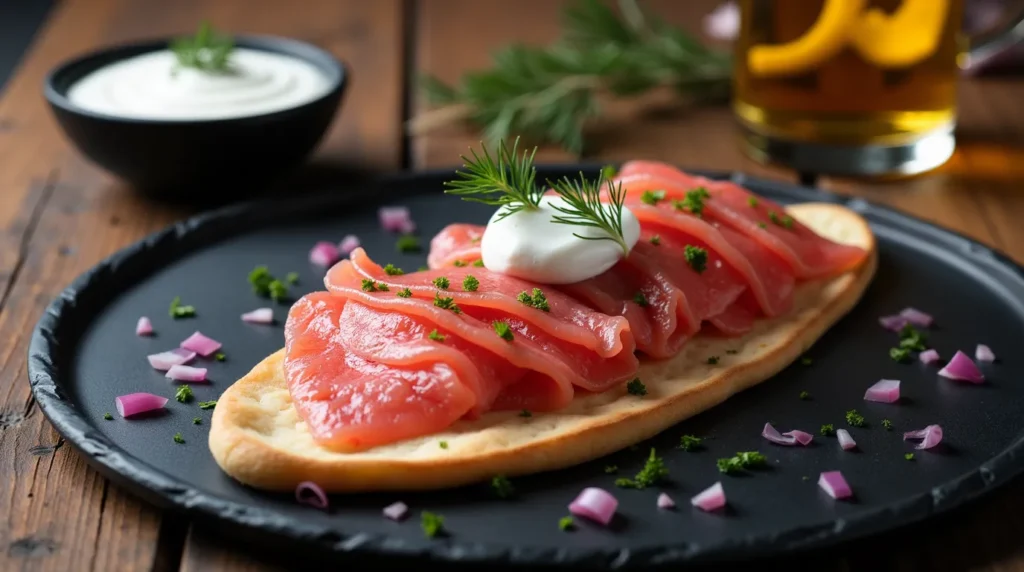
- History and Characteristics: Rakfisk is fermented trout or char, a delicacy in many parts of Norway, especially inland. It is traditionally made by layering gutted fish with salt and storing it under controlled conditions for several months. The result is a pungent, piquant fish that is served thinly sliced on flatbread or lefse, often with sour cream and onions.
- Regional Variations: Fermentation times and methods differ among families, resulting in variations in flavor strength. Some prefer a milder taste, while others relish a sharper, more aged profile.
Pinnekjøtt (Cured Lamb Ribs)
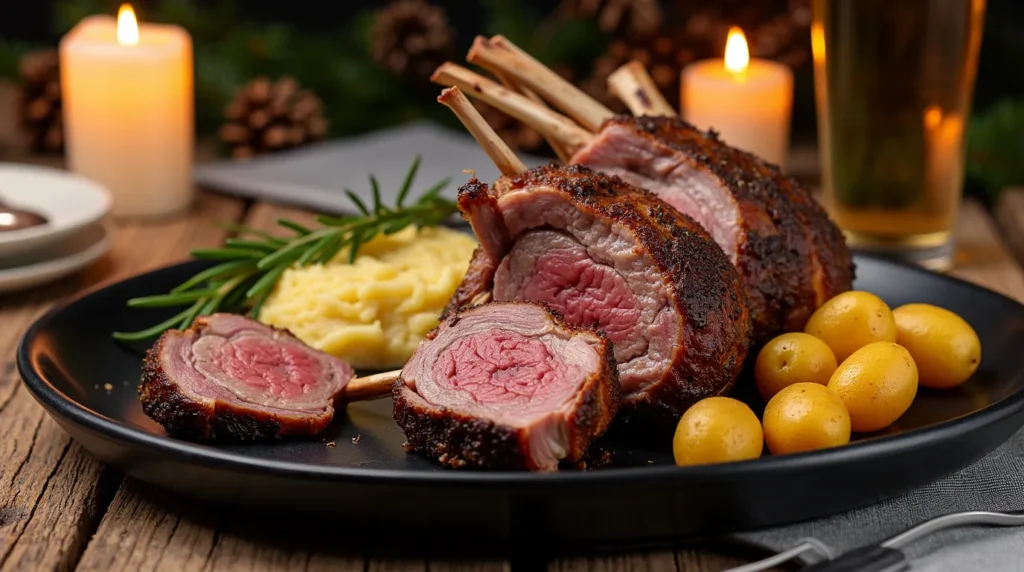
- History and Characteristics: Particularly popular in western Norway during Christmas, pinnekjøtt comprises salted and dried lamb ribs, which are soaked and then steamed over birch sticks. The birch infuses a subtle, smoky aroma, aligning with time-honored preservation methods.
- Simplified Recipe Tips:
- Soak the ribs in water for about 24 hours to remove excess salt.
- Place birch sticks at the bottom of a large pot and add water just below the top of the sticks.
- Layer the ribs on top, cover, and steam until the meat is tender, usually a couple of hours.
- Serve with mashed rutabaga and boiled potatoes.
Kjøttkaker (Norwegian Meatballs)
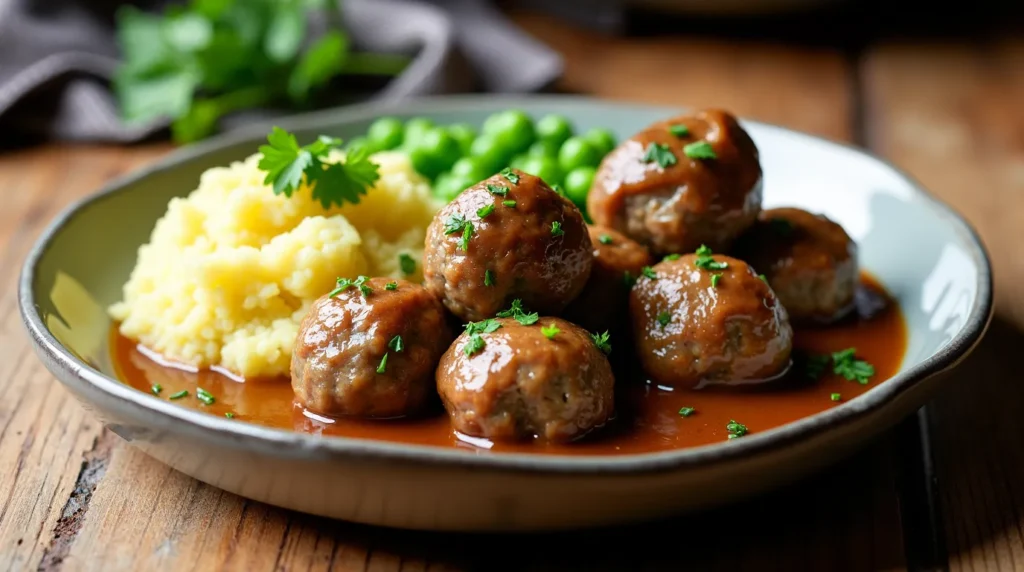
- History and Characteristics: Kjøttkaker are a comforting, everyday dish similar to meatballs in other Scandinavian countries. They are typically made from a mixture of ground beef and pork, seasoned lightly with salt and pepper, and served with gravy, mashed peas, and potatoes.
- Regional Variations: Some versions add spices like ginger or nutmeg; others might incorporate breadcrumbs soaked in milk.
- Making Kjøttkaker: Combine ground meat, salt, pepper, (optional breadcrumbs and egg), form into patties or balls, and fry in butter. After browning, simmer in gravy for a flavorful finish.
Smørbrød (Open-Faced Sandwiches)
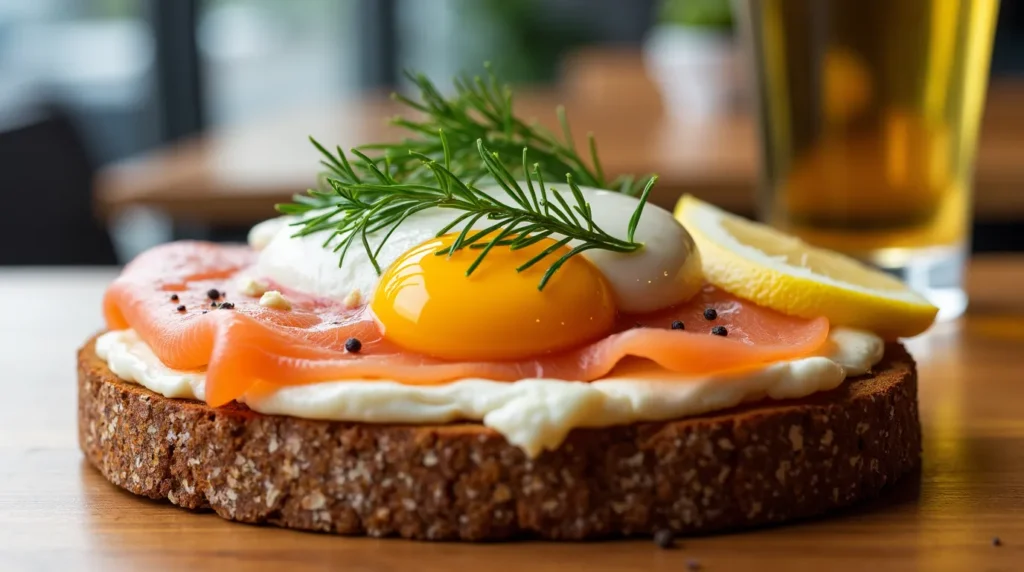
- History and Characteristics: While open-faced sandwiches are a staple across Scandinavia, Norway has a rich tradition of topping robust slices of bread with everything from smoked salmon and dill to mackerel in tomato sauce.
- Ingredients: Rye bread (or knekkebrød), various toppings like cured meats, cheeses, pickled herring, smoked fish, eggs, fresh herbs, and sauces.
- Regional Variations: Western coastal areas might emphasize local fish, while inland versions incorporate reindeer or elk.
- Tips for a Quick Smørbrød: Butter a slice of hearty bread, layer with smoked salmon or pickled herring, top with a dab of sour cream or mustard sauce, and garnish with fresh dill or chives. Simple, elegant, and quintessentially Norwegian.
Links or Tips for Making Them:
- For detailed recipes and instructions, numerous Norwegian cooking websites and food blogs offer step-by-step guides, including the official site of Norway’s tourism board and various cultural associations dedicated to preserving traditional recipes. When cooking items like lutefisk or rakfisk, it is generally best to follow specialized guidelines, as the fermentation and lye-soaking processes demand caution and precision.
Norwegian cuisine places great emphasis on local, sustainable ingredients, ensuring that each dish, whether it is a holiday feast or an everyday meal, resonates with a sense of place. Exploring these dishes is an excellent way to immerse yourself in centuries of cultural evolution, bridging the past and the present through flavors that have withstood the test of time.
Defining Characteristics of Norwegian Cuisine
Subtle and Balanced Flavors
One hallmark of Norwegian cuisine is its relatively mild flavor profile, with spices used sparingly. Rather than masking ingredients with intense seasoning, the culinary philosophy emphasizes letting the natural qualities of the fish, meat, or produce shine through. Salt, pepper, dill, parsley, and juniper berries are among the most commonly used seasonings, with the occasional introduction of caraway or cardamom in baked goods.
Emphasis on Freshness and Preservation
Given Norway’s historical need to preserve food for long winters, techniques such as drying, salting, smoking, and pickling are deeply ingrained. Simultaneously, fresh produce is revered when it is in season, making each fleeting summer harvest or late autumn berry picking a celebratory occasion. Norwegians are known for their attention to quality, understanding that the best taste emerges from the best ingredients.
A Balance of Land and Sea
Though fish and seafood often represent Norwegian cuisine at its most emblematic, game meats like reindeer and elk, as well as hearty root vegetables and dairy, are integral components. This duality — an abundance of seafood matched by a deep tradition of farming and foraging — leads to a culinary style that feels both comforting and bracingly fresh.
Appeal to Food Enthusiasts
Food lovers seeking new experiences may find Norwegian cuisine appealing precisely because it celebrates simplicity and top-notch raw materials. There is an authentic sense of connection to nature and tradition in every meal, whether it’s savoring a plate of smoked salmon with dill or indulging in skillfully prepared reindeer. As fusion trends and evolving techniques gain traction, contemporary chefs are harnessing this heritage to create innovative flavor fusions that surprise and delight.
Tips and Highlights to Encourage People to Try Norwegian Cuisine
- Cultural Immersion: One of the most compelling reasons to explore Norwegian cuisine is the cultural insight it provides. By sampling dishes such as rakfisk, lutefisk, or fårikål, you are directly experiencing centuries of adaptation and culinary creativity in a sometimes harsh environment.
- Seasonal Bounty: When in Norway, make the most of seasonal offerings like fresh berries in summer or the highly valued skrei in winter. Visiting during these peak times can transform the culinary experience from merely tasting local dishes to truly understanding their context.
- Gastronomic Adventures: For the more adventurous eater, Norwegian cuisine includes unique fermented items like rakfisk. Tasting these is not merely about flavor; it’s also about experiencing a proud tradition. While the pungent aroma might be challenging, it often becomes a memorable anecdote in any culinary journey.
- Scenic Backdrop: Even the simplest meal, like open-faced sandwiches enjoyed on a coastline deck, can become extraordinary against the Norwegian landscape. Food in Norway is deeply intertwined with nature, so enjoying a local specialty while gazing at fjords can be a transcendent moment.
- Warm Hospitality: Norwegians value warmth and hospitality, especially when sharing food. Attending local festivals or family gatherings often involves being welcomed with homemade specialties, offering an intimate glimpse into Norwegian life.
- Practical Cooking Tips: If you want to recreate Norwegian recipes at home, remember that the key lies in quality, simplicity, and respect for tradition. Seek out fresh or high-grade preserved ingredients. Where authenticity is difficult (such as sourcing reindeer), adapt using locally available game or similarly flavored meats.
Norwegian cuisine can appeal to people who love discovering the connections between food, land, and culture. Its uniqueness lies in weaving centuries of history and an unwavering commitment to freshness into comforting, nourishing dishes.
Table Rituals and Customs
Daily Meal Structure
- Breakfast (Frokost): Typically consists of bread, crispbread, or knekkebrød topped with cheese (such as brunost), cold cuts, or spreads. Eggs, yogurt, and cereal can also be common. Fresh coffee is a staple, as Norwegians are among the highest coffee consumers per capita in the world.
- Lunch (Lunsj): Usually a light meal around midday, often including open-faced sandwiches or leftovers. In workplaces and schools, packed lunches (matpakke) wrapped in parchment are customary, featuring sandwiches with cheese or cold cuts and perhaps a piece of fruit.
- Dinner (Middag): The main meal of the day, typically in the late afternoon or early evening. Traditional dinners might feature fish, meat, or stew, accompanied by potatoes and vegetables. Gravy or sauce is common, with dairy products like rømme occasionally used as a garnish.
Social Customs and Etiquette
- Invited to a Norwegian Home: It is customary to remove your shoes upon entering. If you are invited for dinner, arrive on time and bring a small gift for the host, such as flowers or chocolates.
- At the Table: Norwegians generally eat continental style, with the fork in the left hand and the knife in the right hand. It is considered polite to wait for everyone to be seated and served before starting to eat.
- Gestures to Avoid: Pointing with utensils, resting elbows on the table, or initiating political or overly personal topics during a meal might be frowned upon. Polite conversation is valued, and any criticisms of the food should be avoided or expressed delicately.
Celebrations and Holidays
- Christmas (Jul): A pivotal time for family feasts and the culmination of many traditional dishes. Pinnekjøtt, ribbe (pork ribs), lutefisk, and rakfisk are commonly enjoyed. Christmas cookies (julekaker) and mulled wine (gløgg) are also prepared.
- Constitution Day (17th of May): Marked by parades, national costumes (bunad), and celebratory meals that often include a festive breakfast or brunch with smoked salmon, cured meats, cheeses, and cakes. Soft ice cream and hot dogs are also popular in street celebrations.
- Midsummer (Jonsok or Sankthans): In some regions, bonfires are lit, and families gather for barbecues or seafood feasts to celebrate the extended daylight.
Family gatherings often feature hearty, comforting food shared in a relaxed atmosphere. Norway’s emphasis on outdoor activities means that many celebrations or even everyday meals might spill out onto balconies, terraces, or picnic spots if the weather permits. Table customs and rituals encapsulate Norway’s blend of practicality, warmth, and a strong sense of community, all of which are reflected in its culinary traditions.
Modern Trends and Culinary Fusions
Global Influences and Fusion Cuisine
Contemporary Norwegian chefs, many trained abroad, have brought back a wealth of techniques and flavor inspirations. In larger cities like Oslo, Bergen, and Trondheim, it is now common to find restaurants blending classic Norwegian ingredients — such as skrei or reindeer — with Asian spices or Mediterranean cooking methods. These cross-cultural collaborations give rise to new interpretations, where Norwegian salmon might be marinated with miso or fenalår is served in innovative tapas-style plates.
New Consumption Trends
- Farm-to-Table: A growing emphasis on sustainable, local agriculture is leading chefs and consumers to support regional producers. Seasonal menu changes are celebrated, echoing the historical reliance on what the land can offer at any given moment.
- Organic Food: Farmers’ markets and organic grocery stores are becoming increasingly common, reflecting a broader trend toward conscious eating. This often goes hand in hand with Norway’s environmental ethos, aiming to preserve the country’s natural beauty and resources.
- Vegetarianism and Veganism: Although traditional Norwegian dishes lean heavily on fish and meat, there is a rise in creative plant-based adaptations. Many restaurants now offer vegetarian spins on classic recipes, using roasted root vegetables, mushrooms, and legumes to mirror the hearty essence of the original dishes.
Young Chefs and Restaurateurs
A new generation of Norwegian chefs is garnering global attention by reexamining traditional recipes. They incorporate avant-garde cooking techniques, forging a style that is both globally informed and rooted in Norwegian heritage. These chefs and restaurateurs are championing hyper-local sourcing, forging relationships with coastal fishermen and inland farmers to highlight the best of each season. Their approach frequently emphasizes minimal waste, echoing Norway’s storied resourcefulness.
In places like Oslo, you can find Michelin-starred restaurants that meld Norwegian cuisine’s principles of simplicity and freshness with global gastronomic flair. The result is a dynamic dining scene that both respects tradition and welcomes innovation. Many of these young chefs use fermentation techniques (inspired by long-standing methods used for rakfisk or pickled herring) in new ways, fermenting seasonal vegetables and fruits to create unique flavor profiles.
This movement also resonates with the global slow-food trend, highlighting the importance of savoring each ingredient, understanding its provenance, and honoring the environment that made it possible. The evolution of Norwegian cuisine thus illustrates an ongoing dialogue between time-honored practices and contemporary creativity — a testament to the adaptability and resilience that has always underpinned Norway’s culinary journey.
Conclusion and Call to Action
Norwegian cuisine is a tapestry of flavor, history, and cultural identity. It arose from pragmatic responses to a challenging environment, which led to innovative preservation methods and a deep-rooted appreciation for locally available resources. Over centuries, external influences, geographical diversity, and evolving tastes shaped a culinary tradition that balances the richness of the sea with the bounty of the land. Modern trends now blend these longstanding traditions with global culinary styles, producing exciting fusions that continue to propel Norwegian cuisine to new frontiers.
As we have seen, this cuisine’s defining characteristics include a mild but distinctive flavor profile, a celebration of fresh and preserved ingredients, and a deep respect for the natural environment. Whether you are savoring a comforting lamb stew in a rustic mountain cabin or enjoying an avant-garde tasting menu in Oslo, Norwegian cuisine offers a unique sensory journey that connects you to Norway’s cultural heritage and stunning landscapes.
We invite you to share your own experiences with Norwegian cuisine. Perhaps you have tasted lutefisk at a festive gathering, experimented with homemade kjøttkaker, or marveled at the sweet, caramel-like notes of brunost. Feel free to send in your favorite recipes, your questions about sourcing Nordic ingredients, or the culinary tales you gathered while traveling through Norway’s fjords. Our hope is that this exploration ignites your curiosity and encourages you to embark on your own culinary adventures — both in Norway and in your home kitchen.
For a future article, we might delve deeper into the art of Scandinavian baking, focusing on breads, pastries, and cakes that merge tradition and innovation across the Nordic region. Until then, may your journey through Norwegian cuisine bring you new flavors, memorable stories, and a deeper appreciation for the remarkable heritage of this Nordic land.
Bon appétit — or, as the Norwegians say, vel bekomme!

